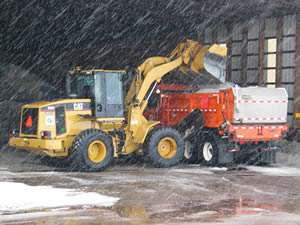 |
|
A worker loads salt into a snowplow at the Baxter truck station during a December storm. Photo by Jenny Seelen
|
This year’s mild winter has been anything but kind to district maintenance budgets.
The warmer than usual weather created frequent freezing rain storms. Temperatures hovering just above and below freezing caused repeated melting and freezing cycles, requiring frequent applications of salt and other de-icers to the state’s highways.
Extended periods of cloudiness reduced available solar energy that can speed the melting process.
In short, a mild winter is becoming a very expensive one.
Salt use increased dramatically between October and the end of January compared with the 2004-05 snow and ice season. Related costs such as overtime and fuel have increased as well.
Rick Arnebeck, Office of Maintenance director, said that Mn/DOT has nearly doubled the amount of salt used compared with the most recent three-year average of 121,000 tons.
This season, he said, Mn/DOT has already used 191,741 tons of salt. Some districts, he said, have already used their allotments for the entire year and have been re-supplied.
This winter, the Metro District already has used 49,821 tons compared with last year’s 41,267 tons. The district’s brine use doubled from 55,598 gallons last winter to 109,420 gallons this season.
Heavier use this winter and higher prices per ton resulted in about $7.8 million spent for salt. Costs vary by location, but the price increased by an average of $4 per ton.
Expenditures for salt last winter totaled about $9 million.
Costs for overtime have risen sharply as crews make additional runs to reapply anti-icing and de-icing chemicals during the freeze and thaw cycles.
Fuel use and prices have also spiraled upward this winter. The amount of fuel used has increased as has the cost per gallon of diesel fuel. At times, Arnebeck said, prices for diesel fuel have exceeded the cost of regular gasoline by several cents per gallon.
Dave Dalager, District 2 maintenance superintendent at Crookston, said his region’s experience this winter includes 15 bouts of freezing rain, blowing snow sticking frequently to warm road surfaces and constant freeze and thaw cycles.
“So far this winter, chemical use is killing us,” Dalager said. “We’re getting close to using more than 18,000 tons; usually, we’d use about 10,000 to 12,000 tons.”
At Detroit Lakes, Maintenance Superintendent Dennis Redig said the picture there mirrors Bemidji’s experience.
“We’ve had a lot of freezing rain and drizzle—not what we usually get up here in the frigid country,” he said.
So far, the district has used more than 15,000 tons of salt compared with 13,500 last winter.
The three districts have also increased their use of brine and other chemicals such as magnesium chloride.
“The freeze and thaw cycles lead to icing in the wheel tracks, so we get lots of people using cruise control or just not paying attention to conditions and ending up in ditches on Interstate-94, Hwy 10 and other roads,” he said.
Redig said District 4 also constantly deals with snow collecting on warm roads and constant temperature fluctuations between just below and just above freezing.
He said district maintenance crews are doing well in spite of working long days and frequent weekend call-outs.
Arnebeck said in addition to higher use of salt and other resources, the warm weather also increases the spread of potholes.
He said the wet pavements also make it more difficult for winter pothole patching materials to bond. Difficulty with patching the potholes further weakens roads, making them even more vulnerable to damage.
“But we know what our worst enemy is—ice,” Arnebeck said.
He said this winter poses many challenges, but there is an upside.
“We’ve gained a lot more experience using anti-icing chemicals,” Arnebeck said, “and Mn/DOT people have responded with their usual resourcefulness, energy and commitment.”
By Craig Wilkins
|



